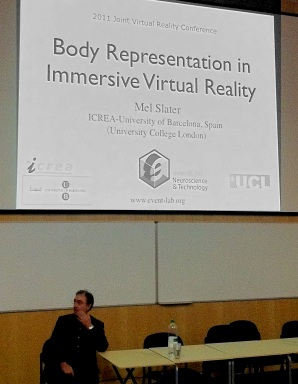This is a summary of Mel Slater‘s keynote at JVRC 2011, entitled “Body representation in Immersive Virtual Reality”.
M. Slater started his talk by stating that the goal of VR is that people act as if what they’re experiencing is real, even though they know it’s not. Your mind accepts the illusion. He insisted that this is not your imagination, it is really a perceptual illusion.
He briefly explained his concepts of Place Illusion and Plausibility Illusion, that are actually unified in the virtual body. The virtual body is also important in that it augments the sense of presence, and improves the estimation of size and distances in VEs (which otherwise tends to be underestimated, even though we don’t know why yet. See studies from Victoria Interrante and Betty Mohler)
Proteus effect
Normally, when you enter a virtual world, you enter it with the same personality, the same “you” (whatever that means). But studies have shown that if you have a different representation of your self, you behave differently ! In a recent study M. Bailenson showed that improving the “attractiveness” of your avatar will transfer as self-confidence in the real world.
This is called the Proteus effect : appearance can transform our behaviors towards other people.
What M. Slater is most interested in is how your appearance affects your own perception, your self-image. This is of great importance for understanding how your brain actually represents your body.
The rubber hand illusion
To try to understand how you can transfer your body in a VE, scientists have conducted several experiments. The most famous one is the rubber hand illusion:
M. Slater translated this experiment in VR, replacing the rubber hand with a virtual hand and showed that it works the same as the original experiment.
One objection against that is that the user might believe that you’re actually going to hurt his real hand, so you have no way of actually knowing if the body has really been transferred or if it’s just the fear of a real injury. They’re actually working on experiments to test this which doesn’t involve real life threat. In the meantime this can be used as a good indication and indeed not a proof of transfer.
The question is then can you transfer your whole body and not just your hand ? Also how much latency or error can be tolerated ? How close to your body does the avatar has to be ? How close to a human does it have to be ?
He showed two examples, the first putting you in a fat avatar, and the second where your arm is stretched and you accept it roughly until it’s three times as big as usual.
Avatars
Some answers were found in other experiments. In an experiment conducted in 1998, Petkova and Ehrsson used a real mannequin as an avatar :
http://www.youtube.com/watch?v=8oF8sQvnTlM(oh and this one is fun too : )
An approaching experiment was conducted by M. Slater in which a user is put in an uncomfortable position, both in real life and in VR. In the VE, the user is alone in a gloomy room and hears strange sounds from the next room. People reported that they were very worried for their safety :
Here’s also how to transfer your body to the body of a young girl :
(and the corresponding article in PLoS ONE)
M. Slater noted that fear is probaby easier to trigger in VR, but that inducing happiness would be quite interesting. That’s one reason a new project called VR-Hyperspace was just created: to try to make you think your body is in a more comfortable position than it is in reality, which could have applications for plane or train travellers.
Conclusions
All these experiments show that virtual embodiment and transformation appears to be possible. It also shows that VR is an excellent tool for cognitive neuroscience, for example to understand how your brain but also that it broadens the possibilities for VR (raw from the presentation) :
– Put yourself in the shoes of the other
– Change in attitudes
– Rehearsal and preparation for events from different standpoints
– Changing how the body feels
Those are really exciting possibilities. I am mostly interested to see what could be done to create empathy; experience another person’s view of a story, his life, for example as a handicapped person. Teaching social interactions could be really beneficial: a recent experiment by Benjamin Lok’s team taught new doctors to speak with a patient, and then enabled the doctor to re-live the talk from the patient’s point of view. This is really helpful to understand the impact of every word you say and how the patient receives and lives them.
But we also have to watch out for the ethical implications of those possibilities, because it could cause even more damage than TV !


Really interesting stuff, thanks for the summary!